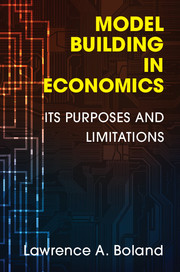Book contents
- Frontmatter
- Dedication
- Contents
- Preface
- Acknowledgements
- Prologue: Model building yesterday versus today
- Part I Theoretical Models
- Part II Empirical Models
- 5 Microeconomic versus macroeconomic empirical model building
- 6 On building macro-econometric models
- 7 Modeling and forecasting
- Part III Testing and Models
- Part IV Methodological Considerations
- Bibliography
- Name index
- Subject index
6 - On building macro-econometric models
Published online by Cambridge University Press: 05 October 2014
- Frontmatter
- Dedication
- Contents
- Preface
- Acknowledgements
- Prologue: Model building yesterday versus today
- Part I Theoretical Models
- Part II Empirical Models
- 5 Microeconomic versus macroeconomic empirical model building
- 6 On building macro-econometric models
- 7 Modeling and forecasting
- Part III Testing and Models
- Part IV Methodological Considerations
- Bibliography
- Name index
- Subject index
Summary
Macroeconomics no longer claims that the study of aggregate phenomena requires a distinct methodology; instead, modern macroeconomic models are intertemporal general equilibrium models, derived from the same foundations of optimizing behavior on the part of households and firms as are employed in other branches of economics.
Michael Woodford [1999, p. 31]Despite its obvious potential, econometrics has not had an easy time from many who have made major contributions to the development of economics, beginning from Keynes’ famous review in 1939 of Tinbergen’s book, Statistical Testing of Business-Cycle Theories. … Forty years after Keynes wrote, his review should still be compulsory reading for all who seek to apply statistical methods to economic observations.
David Hendry [1980, pp. 389, 396]We cannot appeal to the same econometrics that lets a rational expectations econometrician learn an equilibrium because an econometrician is outside the model and his learning is a sideshow that does not affect the data generating mechanism. It is different when people learning about an equilibrium are inside the model. Their learning affects decisions and alters the distribution of endogenous variables over time, making them aim at moving targets.
Thomas Sargent [2008, pp. 13–14]As noted in the Prologue, economists have been building macro-econometric models for well over seven decades. Today, in academic departments, there is a certain homogeneity in macro-econometric model building, although there are differences depending on where the department is located. In North America, the dominant approach to macro-econometric models (briefly mentioned in Chapters 1 and 5) is Dynamic Stochastic General Equilibrium models, usually referred to as DSGE models. The other approach, promoted mostly in a few universities in Europe, is usually called the Cointegrated Vector Autoregression approach, often referred to as the CVAR approach. The differences also extend to the related methodological approaches concerning which comes first, model construction or analysis of the statistical adequacy of the available data. This chapter will be about these two approaches. It will again discuss the use of the representative agent in the development of empirical macro-econometric models particularly in the context of the alleged need for micro-foundations for any complete macro model.
- Type
- Chapter
- Information
- Model Building in EconomicsIts Purposes and Limitations, pp. 105 - 122Publisher: Cambridge University PressPrint publication year: 2014

